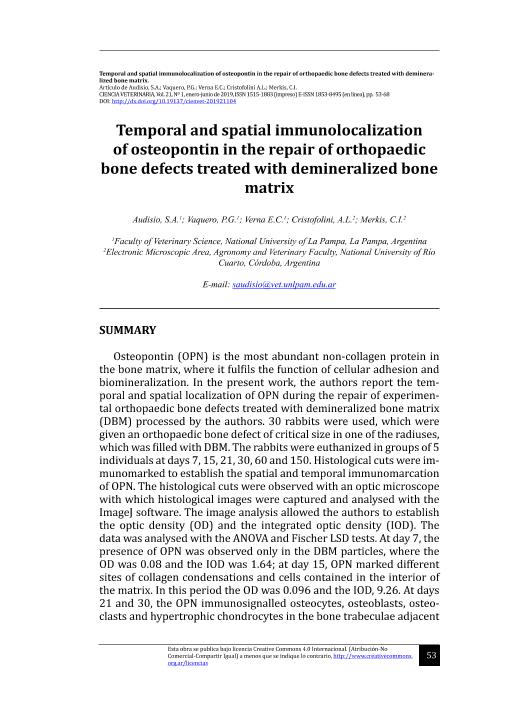Artículo
Osteopontin (OPN) is the most abundant non-collagen protein in the bone matrix, where it fulfils the function of cellular adhesion and biomineralization. In the present work, the authors report the temporal and spatial localization of OPN during the repair of experimental orthopaedic bone defects treated with demineralized bone matrix (DBM) processed by the authors. 30 rabbits were used, which were given an orthopaedic bone defect of critical size in one of the radiuses, which was filled with DBM. The rabbits were euthanized in groups of 5 individuals at days 7, 15, 21, 30, 60 and 150. Histological cuts were immunomarked to establish the spatial and temporal immunomarcation of OPN. The histological cuts were observed with an optic microscope with which histological images were captured and analysed with the ImageJ software. The image analysis allowed the authors to establish the optic density (OD) and the integrated optic density (IOD). The data was analysed with the ANOVA and Fischer LSD tests. At day 7, the presence of OPN was observed only in the DBM particles, where the OD was 0.08 and the IOD was 1.64; at day 15, OPN marked different sites of collagen condensations and cells contained in the interior of the matrix. In this period the OD was 0.096 and the IOD, 9.26. At days 21 and 30, the OPN immunosignalled osteocytes, osteoblasts, osteoclasts and hypertrophic chondrocytes in the bone trabeculae adjacent to the ossification zones. At day 21 the OD was 0.17 and IOD 6.22. At day 30, the OD was 0.14 and the IOD 2.52. At days 60 and 150, OPN was evenly distributed in the new bone matrix with an OD: 0.10 and IOD: 0.48, and OD: 0.35 and IOD: 3.80, respectively. The OD and IOD showed significant differences (p<=0.05) between days 7, 15, 21 and 30; and there was no difference at days 60 and 150 (p=0.05). OPN was found in the DBM particles: it increased the optic densities at day 15 and it diminished at day 60, after which it increased the OD and IOD again until day 150. It was established that the OPN immunoexpressed during the repair process in indifferentiated cells, osteoprogenitor chondrocytes and osteoblasts. The variation of OD and IOD allowed the authors to establish that the greatest degree of immunoexpression of OPN was at day 15 after repair initiated. On the other hand, the increase registered between days 60 and 150 post treatment was due to the biomineralization of the bone matrix. La osteopontina (OPN) es la proteína no colágena que más abunda en la matriz ósea, donde cumple funciones de adhesión celular y biomineralización. En el presente trabajo se informa la localización temporal y espacial de la OPN durante la reparación de defectos óseos ortopédicos tratados con matriz ósea desmineralizada (MOD). Se emplearon 30 conejos a los que se les practicó un defecto óseo ortopédico de tamaño crítico en uno de sus radios. Los defectos se rellenaron con MOD obtenida según protocolo previamente informado. Los conejosfueron sacrificados en grupos de 5 a los 7, 15, 21, 30, 120 y 150 días de los cuales se recuperaron los defectos para identificar las estructuras histológicas y establecer la inmunomarcación espacial y temporal de OPN. Se realizaron cortes histológicos de los defectos que se tiñeron con hematoxilina y eosina (HE) e inmunomarcaron según técnicainmunohistológica. Los cortes inmunomarcados se observaron en un microscopio óptico de donde se capturaron imágenes histológicas a 20X para analizarlas con el software ImageJ y establecer la densidad óptica (DO) y densidad óptica integrada (DOI). Los datos se analizaron con un test ANOVOA y LSD Fisher. A los 7 días se observó la presencia de OPN solo en las partículas de MOD donde la DO: 0,109 y DOI: 3587,043; a los 15 días OPN marcaba distintos sitios de condensaciones colágenas y células en su interior, en este período DO fue 0,096 y la DOI: 10593,08. A los 21 y 30 días OPN señalaba trabéculas óseas, osteocitos, osteoblastos, osteoclastos y condrocitos hipertróficos inmediatos a las zonas de osificación, la DO fue 0,134 y DOI 14.639,7. A los 120 y 156 días OPN se encontraba uniformemente distribuida por la matriz del hueso nuevo con una DO: 0,0104; DOI: 4160,96 y DO: 0,081 y DOI 8878,9 respectivamente. Las DO y DOI mostraron diferencias significativas (p<=0,05) entre los 7, 15, 21 y 30 días y no existió diferencia a los días 120 y 150 días (p=0,05). OPN se halló presente en las partículas de MOD e incrementó las densidades ópticas a los 15, 21 y 30 días como producto del metabolismo celular posibilitando la adhesión celular y luego interviniendo en la biomineralización.
Temporal and spatial immunolocalization of osteopontin in the repair of orthopaedic bone defects treated with demineralized bone matrix
Título:
Inmunolocalización temporal y espacial de osteopontina en la reparación de defectos óseos ortopédicos tratados con matriz ósea desmineralizada
Audisio, Santiago Andrés; Vaquero, Pablo Guillermo; Verna, Edgardo Cesar; Cristofolini, Andrea Lorena ; Merkis, Cecilia Inés
; Merkis, Cecilia Inés
 ; Merkis, Cecilia Inés
; Merkis, Cecilia Inés
Fecha de publicación:
06/2019
Editorial:
Universidad Nacional de La Pampa. Facultad de Ciencias Veterinarias
Revista:
Ciencia Veterinaria
ISSN:
1515-1883
e-ISSN:
1853-8495
Idioma:
Inglés
Tipo de recurso:
Artículo publicado
Clasificación temática:
Resumen
Palabras clave:
RABBIT
,
BONE
,
OSTEOPONTIN
,
IMMUNOMARCATION
,
DESMINERALIZED BONE MATRIX
Archivos asociados
Licencia
Identificadores
Colecciones
Articulos(CCT - CORDOBA)
Articulos de CTRO.CIENTIFICO TECNOL.CONICET - CORDOBA
Articulos de CTRO.CIENTIFICO TECNOL.CONICET - CORDOBA
Citación
Audisio, Santiago Andrés; Vaquero, Pablo Guillermo; Verna, Edgardo Cesar; Cristofolini, Andrea Lorena; Merkis, Cecilia Inés; Temporal and spatial immunolocalization of osteopontin in the repair of orthopaedic bone defects treated with demineralized bone matrix; Universidad Nacional de La Pampa. Facultad de Ciencias Veterinarias; Ciencia Veterinaria; 21; 1; 6-2019; 53-68
Compartir
Altmétricas



